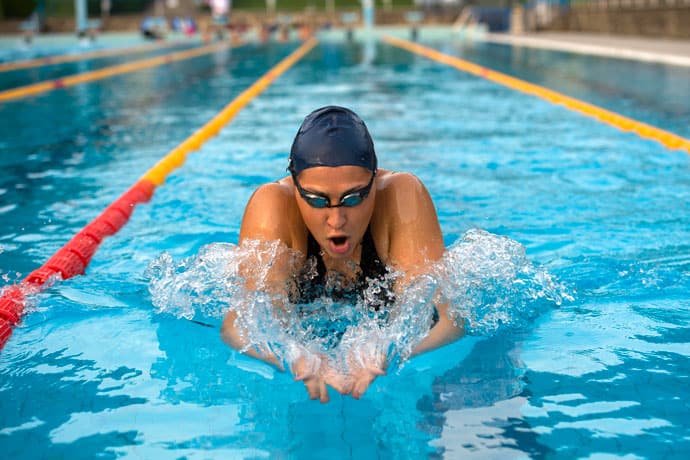Pilates is a popular workout program centered around stretching and strengthening the various muscle groups of the body. The workout brings together a combination of yoga, gymnastics and physical therapy to provide a well-rounded exercise that may be done on a mat or on a fitness machine called a reformer. Exercises cover the whole body. Some focus on sculpting the abdominals, while others work out the arms and shoulders, or the low back.
Practicing basic Pilates moves alone
While nothing beats the hands-on instruction of attending a Pilates class in person, mastering a few moves yourself can help you squeeze in a workout when you’re short on time. Here’s a step-by-step guide to performing seven essential Pilates moves.
Best Pilates exercises for beginners
The breaststroke
 Pilates experts tout the breaststroke as a move that can help you appear taller. The move helps you lengthen your spine, stretching it out after days of slouching and slumping. You’ll perform this by lying on your stomach, placing arms at your sides with your feet hip distance apart.
Pilates experts tout the breaststroke as a move that can help you appear taller. The move helps you lengthen your spine, stretching it out after days of slouching and slumping. You’ll perform this by lying on your stomach, placing arms at your sides with your feet hip distance apart.
- Slide shoulders down your back, exhaling to lift the upper body off of the mat. Keep in mind that you’re only lifting about two inches off the ground, it’s not a dramatic lift.
- As you lift, expand the collarbone by squeezing your shoulders together as if you’re trying to get them to touch.
- Engage your glutes and take a deep inhale as you lower down to the mat.
- Repeat for several sets.\
The hundred
The hundred is one of the more popular Pilates mat exercises. Most classes feature the hundred, as the activity warms up the abs and the lungs, and gets you used to coordinating your breathing with every movement.
- Start by lying flat on your back, with legs bent into a tabletop position. Make sure ankles and shins are positioned so that they are parallel to the floor.
- On your exhale, lift your head and tilt your chin down toward your chest.
- Use your abdominal muscles to lift the upper spine off the floor, curling your spine to the base of your shoulder blades.
- At the same time, keep your shoulders engaged, sliding down your back. Keep eyes cast downward, looking toward the abdominals. Inhale.
- Upon exhale, engage your core deeper, and extend the arms and legs. Your legs are now sticking out straight in front of you. For a bigger challenge, adjust them lower. But that said, they should not be so low that they are shaking or that your spine is coming off of the ground.
- Keep your arms straight, a few inches off the floor with fingers pointing toward the wall.
- Stay here and take five short breaths in, followed by five short breaths out. These should be small puffs. At the same time, move both arms up and down in a small, controlled pumping motion. Relax the head and shoulders, keeping your abs engaged.
- Repeat the breath work and arm motions for 10 sets.
- At the end of the last set, finish by keeping the spine curved, drawing the knees in toward your chest. Hug the knees and roll the head and spine gently down toward the mat.
The spine twist
The spine twist is a multi-functional exercise. For one, it strengthens and stretches the spine, meaning it will help counteract all that hunching over at your computer by improving your posture. It also works out your upper back, obliques, rhomboids, upper trapezius, delts and hamstrings.
- Get started by sitting on your mat, with your legs in front of you, spine long and feet flexed.
- Inhale deeply, then exhale. As you do so, pull in the abs and drag in the navel toward the spine.
- Inhale with your arms out to the sides with you palms facing forward and your shoulders relaxed.
- On the exhale, rotate your body to the right and extend your left arm toward the feet.
- Inhale back to center, with arms placed at the sides once again. Then, switch sides and repeat 10 times.
The roll up
The roll up targets your abdominal muscles. Think of this one as a gentle alternative to doing crunches, more akin to yoga’s boat pose.
- Start by lying on your back with arms at your sides and legs together. Inhale while lifting your arms up toward the ceiling. Then, gently exhale while rolling your body all the way up.
- Try reaching your toes and stretching your hamstrings. At the same time, keep the neck in a neutral position, and press the heels into the mat, engaging your core as you roll up.
- When you reach your toes, take another inhale. Then, exhale and roll your body down to the mat in your starting position.
- Repeat for 10 sets.
The leg circle
The leg circle is another move that targets the thighs. This is a fairly straightforward move you can do anytime you’re watching TV or even chatting on your smartphone.
- Start with a neutral spine. Reach your right leg up to the ceiling, pulling your stomach muscles in at the same time. Point the toes, then move your leg in small, circular motions.
- Keep your abs engaged, with shoulders and hips touching the mat.
- Complete the circle again, in reverse. To release, grasp your knee. Stretch and lower the leg down to the mat.
- Do the same for the left side.
The shoulder bridge
Although the shoulder bridge is named for the upper body region, the hamstrings are the body part that reaps the most benefits from this exercise.
- Start on your back, legs hip-width apart, with your feet on the mat and your arms palm-down at your sides.
- Engage your glutes and lift the hips off of the mat. Make sure your knees, hips and feet remain in alignment.
- Take a deep inhale and bring your navel to your spine. Lift one leg out in front of you, point your toes, and extend the leg to the ceiling.
- Then exhale, foot flexed, lowering your leg to knee-level.
- Repeat five times on each side.
- When finished, gently lower back down to the mat.
The kneeling side lift
A powerful thigh-toning exercise and one of the more streamlined Pilates moves in the mix, kneeling side lifts can be performed anywhere with a little floor space.
- Get into a kneeling position, making sure you have plenty of room on each side.
- Lower your left hand to the ground. Then, extend your right arm out, holding your right hand behind your head.
- Lift the right leg to about hip-height, then gently lower it back down. Repeat for 10 reps.
- Hold the right leg at hip height and rotate the leg in small circles. Repeat 10 times.
- Switch sides and repeat the process from start to finish.
These essential Pilates moves for beginners are fairly easy to do on your own with a little practice and attention to form. However, we do recommend trying out a class or following along with a Pilates video before branching out on your own. Proper form is crucial to maximizing the benefit of Pilates. By learning to keep a neutral spine and knowing when to suck in your abdominals, you’ll be able to tone your body while remaining injury free.
I’m not just a supplement analyst. I’m an extremely qualified one! I am a Certified Nutrition Coach (CNC) and actually received my certification directly from the National Academy of Sports Medicine. I am also a Nutrition & Wellness Consultant, certified by the American Fitness Professionals Association (AFPA).


